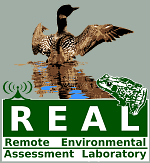With the growth and expansion of human populations
has come an increasingly greater need to understand
the dynamics of ecosystems and their complex
interactions. As urban areas continue to expand,
fragile surrounding ecosystems are often affected
as they are redesigned to support urban
infrastructure. For instance, the fragmentation
of forests within the National Parks and Reserves,
and its effects on animal habitats, is becoming
a significant problem.
Acoustic signals have been used for many years to
census vocal organisms. For example, the
North American Breeding Bird Survey, one of the largest long-term, national-scale
avian monitor programs, has been conducted for more
than thirty years using human auditory and visual cues.
The North American Amphibian Monitoring Program is based on identifying
amphibian species primarily by listening for their
calls. Recent advances in sensor networks enable
large-scale, automated collection of acoustic
signals in natural areas. The systematic and
synchronous collection of acoustic samples at
multiple locations, combined with measurements of
ancillary data such as light, temperature, and
humidity, can produce an enormous volume of
ecologically relevant data. Transmuting this
raw data into useful knowledge requires timely and
effective processing and analysis.
The potential for automating environmental monitoring
using acoustic and other sensor types in conjunction
with advanced computational techniques is
significant. A holistic solution (sensor-to-user)
is required to enable interpretation of the
soundscape. Although sound has been used to
conduct species specific census of organisms that
communicate using acoustics, there is significant
work to be done to enable the scientific community
to apply acoustics to the task of environmental
monitoring. REAL has identified four research
areas that are important for implementing an
holistic solution:
sensor technologies,
soundscape interpretation,
ecosystem assessment, and
data stewardship.

